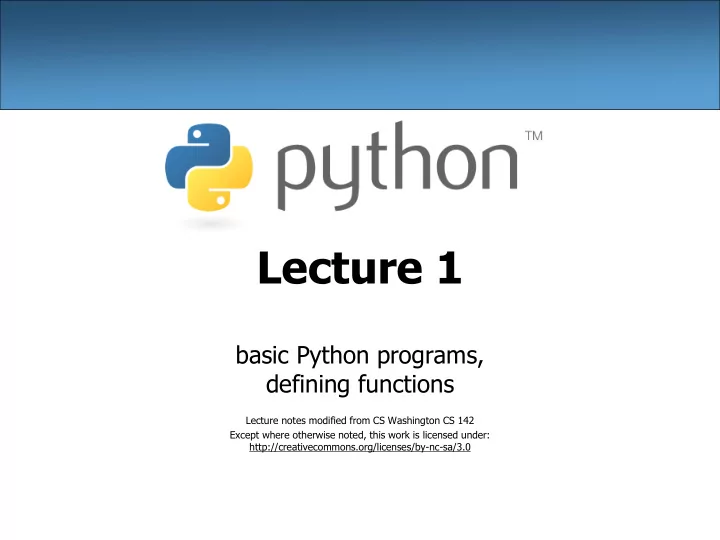

Lecture 1 basic Python programs, defining functions Lecture notes modified from CS Washington CS 142 Except where otherwise noted, this work is licensed under: http://creativecommons.org/licenses/by-nc-sa/3.0
Python! • Created in 1991 by Guido van Rossum (now at Google) – Named for Monty Python • Useful as a scripting language – script : A small program meant for one-time use – Targeted towards small to medium sized projects • Used by: – Google, Yahoo!, Youtube – Many Linux distributions – Games and apps (e.g. Eve Online) 2
Interpreted Languages • interpreted – Not compiled like Java – Code is written and then directly executed by an interpreter – Type commands into interpreter and see immediate results Runtime Java/C: Code Compiler Computer Environment Python: Code Interpreter Computer 3
The Python Interpreter • Allows you to type commands one-at-a-time and see results • A great way to explore Python's syntax – Repeat previous command: Alt+P – Next command: Alt+N 4
Running Python Program • Python does not have a main method like Java or C – The program's main code is just written directly in the file • Python statements do not end with semicolons • Python two running modes: – Interactive Python Shell mode – IDLE Python source file – create, edit, and running 5
Python Interactive Shell • When you start up IDLE, a window with an interactive Python shell will pop up: • You can type Python code directly into this shell, at the '>>>' prompt. • Whenever you enter a complete code fragment, it will be executed. 6
Python Interactive Shell Python Interactive Shell Practice: The print command outputs text directly to the Python shell >>> print(‘hello there’) hello there >>>print( ) >>>print(4+6) 10 >>>print(8**3) 512 7
Number vs String • Number: Numeric value can be added, subtracted, multiplied, divided, etc • String: a string value is a value that can contain any combinations of characters, it'll normally get used for an address or similar, you can put what you want there really. In Python, single quote, ‘hello’ or double quotes “hello” In Python Shell prompt, try >>> print(123+53) 176 >>>print(’123+53’) 123+53 More on these will be covered later. 8
Python IDLE File • In IDLE, go to FILE New Create a new python file (Open -> open an existing Python file) • You can edit/modify/create a Python file and run it (IDLE- >RUN-> RUN MODULE) Demonstrate, and create a new hello.py file with these python commands. 9
A Brief Review 10
The print Statement print(" text ") (a blank line) print() – Certain special characters must be prefixed with a backslash – Strings can also start/end with ' swallows.py 1 print("Hello, world!") 2 print() 3 print("Suppose two swallows \"carry\" it together.") 4 print('African or "European" swallows?') 11
Comments • Comments are ignored • Syntax: # comment text (anything after the # on the same line is ignored) swallows2.py 1 # Suzy Student, Raspberry Pi Camp, Summer 2016 2 # This program prints important messages. 3 print("Hello, world!”) 4 print() # blank line 5 print(”Suppose two swallows \"carry\ " it together.”) 6 print('African or "European" swallows?’) 12
Functions • Function : A block of Python commands executed together. • Syntax: hello2.py def name (): statement 1 # Prints a helpful message. 2 def hello(): statement 3 print("Hello, world!”) 4 ... 5 # main (calls hello twice) statement 6 hello() 7 hello() – Must be declared above the 'main' code – Statements inside the function must be indented 13
Whitespace Significance • Python uses indentation to indicate blocks – Makes the code simpler and more readable – In Java/C, indenting is optional. In Python, you must indent. hello3.py 1 # Prints a helpful message. 2 def hello(): 3 print("Hello, world!”) 4 print("How are you?”) 5 6 # main (calls hello twice) 7 hello() 8 hello() 14
Exercise • Rewrite the figures.py lecture program in Python, so it outputs: ______ / \ / \ \ / \______/ \ / \______/ +--------+ ______ / \ / \ | STOP | \ / \______/ ______ / \ / \ +--------+ 15
Exercise Solution def egg(): def top(): top() print(" ______”) bottom() print(" / \\ ”) print print("/ \\ ”) def cup(): def bottom(): bottom() print("\\ /”) line() print(" \\ ______/”) print def line(): def stop(): print("+-------- +”) top() print("| STOP |”) # main bottom() egg() print cup() stop() def hat(): hat() top() line() print 16
Recommend
More recommend